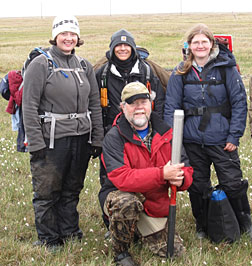- Number 385 |
- April 1, 2013
Colleen Iversen's outdoor childhood sparked underground research

Colleen Iversen (far left) accompanied
ORNL colleagues Joanne Childs, Rich Norby
(kneeling), and Victoria Sloan on the trip to
Alaska for the NGEE Arctic project.
As the daughter of hydrogeologists, Colleen Iversen was raised to explore mountains and caves. Disguised as family vacations, trips to study rocks and groundwater movement fueled her love of nature and the need to study and preserve it.
Years later, following studies at Hope College and the University of Notre Dame that culminated in a doctorate in Ecology and Evolutionary Biology at the University of Tennessee in Knoxville, Iversen is a staff scientist at Oak Ridge National Laboratory. But instead of studying hydrogeology like her parents, Iversen is an ecosystem ecologist focusing her research on how climate change affects carbon and nutrient cycling in roots and soil systems.
“Fine plant roots are an important component of ecosystem carbon and nutrient cycling,” Iversen says. “The production of fine roots can contribute one-third of annual plant production, and roots are responsible for plant uptake of nutrients and water. Therefore, they directly mediate the survival and growth of plants that take up atmospheric CO2 via photosynthesis. The death and decomposition of fine roots also contribute to the accumulation of carbon and nutrients in the soil.”
As awareness of global climate change increases, belowground processes are an area of major interest to researchers, especially in peatlands and other high-latitude ecosystems where climate change is more apparent, and where major carbon pools exist in the soil because of the cold climate and low soil oxygen conditions.
Iversen works on several experiments around the world to help scientists understand the effects of increasing global temperatures and atmospheric carbon dioxide levels on belowground processes.
At the Spruce and Peatland Responses Under Climatic and Environmental Change (SPRUCE) experiment in a peat bog at the Marcell Experimental Forest in northern Minnesota, Iversen and others have installed underground cameras called minirhizotrons to track root growth in response to experimental warming and elevated carbon dioxide concentrations. The ten-year experiment will help scientists to determine the levels of warming at which peatland ecosystems will reach a critical threshold in carbon storage.
Iversen also works with the vegetation team of the Next-Generation Ecosystem Experiments (NGEE-Arctic) in Barrow, Alaska. Her research is furthering the understanding of the effects of permafrost degradation on arctic plant communities. The data will be used to develop algorithms to model and predict future climate changes in the Arctic.
At ORNL, Iversen studied the growth and death of roots in 12-year Free-Air CO2 Enrichment (FACE) experiment in a sweetgum plantation. The ORNL FACE experiment, which also served as her dissertation project, tracked tree growth patterns, nutrient uptake, and carbon storage under elevated CO2 levels meant to simulate the expected atmospheric CO2 levels in the year 2050.
Still passionate about science all of these years after her first family vacation to explore rock formations, Iversen is looking to contribute to our understanding and prediction of atmospheric and climatic change in any way possible.
“New insights on these processes contribute to improved ecosystem and landscape simulations, which helps the modeling community project future climates," Iversen says. "With these simulations, policy makers can better understand the risks current decisions will present to future climates and human society,” she says. – Josh HastonSubmitted by DOE's Oak Ridge National Laboratory
